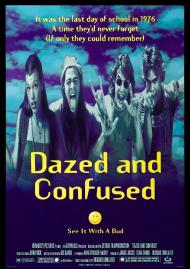Movie Review
American Graffiti
Where were you in '62?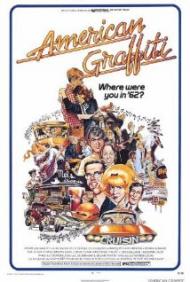
US Release Date: 08-11-1973
Directed by: George Lucas
Starring▸▾
- Richard Dreyfuss, as
- Curt
- Ron Howard, as
- Steve
- Paul Le Mat, as
- John
- Charles Martin Smith, as
- Terry
- Cindy Williams, as
- Laurie
- Candy Clark, as
- Debbie
- Mackenzie Phillips, as
- Carol
- Wolfman Jack, as
- Disc Jockey
- Bo Hopkins, as
- Joe
- Manuel Padilla Jr., as
- Carlos
- Beau Gentry, as
- Ants
- Harrison Ford, as
- Bob Falfa
- Jim Bohan, as
- Holstein
- Jana Bellan, as
- Budda
- Deby Celiz, as
- Wendy
- Kathleen Quinlan, as
- Peg
- Suzanne Somers, as
- Blonde in T-Bird
- Susan Richardson as
- Judy
![3.75 star[s] out of 4](http://www.threemoviebuffs.com/static/images/global/featured_gold_stars.png)
![3.5 star[s] out of 4](http://www.threemoviebuffs.com/static/images/global/featured_gold_stars.png)
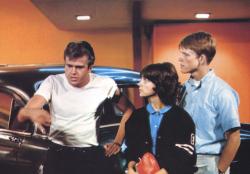
Paul La Mat, Cindy Williams and Ron Howard in American Graffiti
I loved American Graffiti when I first saw it on HBO. I was in school and these teenagers seemed so incredibly free, staying up all night having all kinds of wonderful experiences. Having been a fan of "Happy Days" and "Laverne and Shirley", these characters seemed extremely familiar. Watching it today, I kept thinking, “Where are these kids’ parents?” Cindy Williams even states on the DVD making of section that her character is only 16. What in the hell is she doing staying out until sunrise?
The fact that I view this film differently now than when I first saw it, is pretty much the point of the story. This one night finds a group of young people saying good bye to the lives they knew. Curt and Steve have graduated from high school and are both leaving for college the next day. This is their last night with their hometown friends and girlfriends.
Curt is unsure that he even wants to go away. Steve breaks up with his girlfriend Laurie, who is still in high school; because he understands the distance will break them up anyway. John is clearly based on James Dean and was the inspiration for Fonzie. John wears boots, blue jeans and a plain white t-shirt with a pack of cigarettes wrapped up in his sleeve.
His storyline is the most telling even though it is the least eventful. He has always been the big man on the strip with his hotrod outdoing anyone else who dared to drive down his streets. He has a scene where he complains that rock n roll is no longer good because Buddy Holly has died and surfer music, like the Beach Boys, is becoming popular. His time spent with the young Carol is symbolic in that even though she is only supposed to be a few years younger than him; they are at two very different points in their lives. Whereas he may seem on the surface as very immature to most adults, compared to Carol he is actually the mature one.
Not only was this low budget hit an inspiration for "Happy Days", but much of the then unknown cast went on to huge success in movies and on television. It was the first film to use original recordings of pop songs as its soundtrack. There is no background music.
The story in American Graffiti is about the changing times and lives of young people at a cross roads. In a philosophical sense, it is about the changing of our country, taking place just before the Beatle invasion and Vietnam War. Professionally speaking, it was vastly important to all involved. Without American Graffiti, countless television shows would not have existed or at least not how we remember them. Dreyfuss and Ford may not have had the careers they did and of course, without the success of this film, would anyone have thought to finance Star Wars.
American Graffiti was one of the most financially successful films ever made. It left a huge legacy that cannot be over looked. And lest I forget to add, it is also a damn good piece of entertainment.
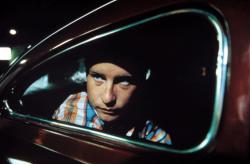
Richard Dreyfuss in American Graffiti.
Given how successful and influential this movie became, it might be hard to believe, but nearly every studio in Hollywood passed on it until Universal reluctantly agreed to finance it, encouraged by the fact that Lucas's friend and mentor, Francis Ford Coppola, agreed to act as producer. Coppola's involvement allowed them to market the film as, "from the Man who Gave you The Godfather". Even after the film was finished, the studio lacked confidence in it, contemplating releasing it as a TV film, insisting on edits to keep it at 110 minutes, and offering alternative title suggestions, such as "Another Slow Night in Modesto". Only when positive reports started coming in from test audiences, did the studio really get behind it, pumping $500 thousand into publicity, fully two-thirds of what the film cost to actually make.
Although the four main characters are all close to the same age, Lucas based them on different stages of his own teenage years in Modesto, California. Toad was his youngest self, nervous and awkward around girls. He grew in confidence when he discovered cars and got a girlfriend, becoming a drag race champion closer to the John and Steve characters. And finally, when he left his hometown to go off to college, he became Curt. Obviously they are all heightened versions of himself, given the Hollywood treatment for dramatic effect, but it is undoubtedly the fact that Lucas grew up in a town like the one featured in this movie, during the same time period, driving the same cars and listening to the same music that gives this movie its resonance.
As Eric wrote, this one night shows the characters at a crossroads in their young lives. They're at that fragile, oh-so-brief, moment between childhood and responsible adulthood. This one night doesn't alter their future or set anything in stone, but it does mark a turning point for most of them. Steve decides to stay in his hometown, while Curt goes off to college, something the film has foreshadowed all along with the girl in the white t-bird. Curt pursues her through the movie, still looking for something out there, while Steve is already grounded in his relationship with Laurie. Toad and John are less changed, although perhaps Toad has gained a little confidence from his night with Debbie. John's storyline is the most melancholy. In some ways he represents the audience's point-of-view. He's looking back with longing at a simpler time, when the strip was bigger, the girl's were prettier and the music was better. His coming to terms with Carol, who represents the next-generation, is perhaps a sign that he's coming to terms with the way things are changing.
One element that Eric didn't really touch upon, is the comedy. This is a very funny movie with genuine laugh out loud moments. Toad, played by Charles Martin Smith, provides some of the film's most blatant comic moments, such as his attempts to buy alcohol, or his scene with Debbie as she describes the Goat Killer, but each of the characters gets a few funny scenes. Even at its funniest moments though, it remains grounded and the characters remain real.
The film ends with captions that detail the four main character's fate and is a surprisingly downbeat ending that casts a pall over what comes before it. They also only detail the male character's outcome. For instance, we learn that Steve stayed in his hometown and became an insurance salesman, but there's no mention of if he married Laurie or not.
While Hollywood was slow to recognize this movie as a hit, it wasn't slow in trying to imitate it. Its success, however, didn't help studios to recognize future successes. Lucas, in signing with Universal had also agreed to give them first look rights for his next film. When he pitched them his idea for a space opera, entitled Star Wars, they rejected it outright. Fortunately for Lucas and audiences, the money he earned from this film enabled him to move ahead on that project anyway.
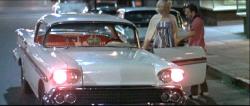
Candy Clark and Charles Martin Smith in American Graffiti.
Eric, if you spent any time worrying about why Laurie was allowed to stay out all night you missed the point of the movie, which is the end of the freedom and innocence of both an era and the childhood's of these characters. Clearly Laurie's parents trusted her, and they knew this was her last night to spend with her boyfriend Steve, as well as her brother Curt. At any rate it isn't germane to the plot.
American Graffiti is all about nostalgia and how these various characters react to the changes that are coming. Notice how Curt and Steve attend the Junior Prom for one last look at the old high school where they spent so much of their adolescence. John makes fun of them for going. This is because they are emotionally ready to move on while he is afraid of change and the passing of time. John is only 22 years old but he's already looking back and pining for his glory days.
The music, fashion, and cars of the period give this movie a very specific look. George Lucas himself grew up in Modesto, where this story is set. Ironically, Lucas felt that his hometown had changed too much in the decade that had passed since the movie takes place. He opted to film the primary exterior scenes in San Rafael, and later Petaluma. At any rate the look of the movie is spot on in every detail.
The 41 songs heard throughout the movie are the soundtrack of a generation. In the same way that The Graduate was groundbreaking in its use of original pop songs, American Graffiti created the blueprint for how to incorporate hit songs into a movie. It has been copied countless times in the past 40 years.
There are many great moments in this movie. I always enjoy the scene where Curt visits the radio station and meets Wolfman Jack. The Wolfman denies who he is but Curt surreptitiously learns the truth on his way out the door. It provides one more nudge in his decision of whether or not to go away to college the following morning.
There is a palpable poignancy in American Graffiti. It takes place on the last night of summer vacation. For Curt and Steve it is the last night of their adolescence with adulthood rapidly approaching. John, on the other hand, is trying to outrace responsibility, even as it is quickly gaining on him in his rear view mirror.
The humor in American Graffiti is perfectly blended with its sense of nostalgic yearning. My one and only complaint is the fact that, as Scott mentioned, Lucas only included the fates of the men in the story. It reduces the female characters to less than complete human beings. But then again perhaps this is apt, since the story takes place before the advent of Women's Lib.
Photos © Copyright Universal Pictures (1973)

